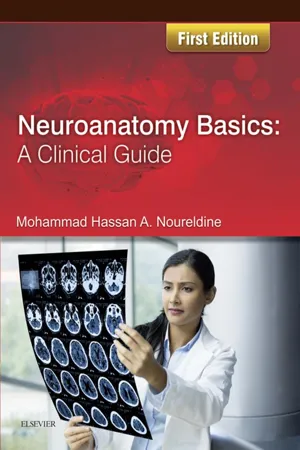
Neuroanatomy Basics: A Clinical Guide E-Book
Neuroanatomy Basics: A Clinical Guide E-Book
- 422 pages
- English
- ePUB (mobile friendly)
- Available on iOS & Android
Neuroanatomy Basics: A Clinical Guide E-Book
Neuroanatomy Basics: A Clinical Guide E-Book
About this book
A hands-on tool for medical students, Neuroanatomy Basics: A Clinical Guide covers key basic neuroanatomy material and the most important clinical correlations that a medical student is required to know. The book's style is simple and features an array of figures/illustrations that will show the student what he/she has just studied. It will follow a breadcrumbs approach that relies heavily on images/figures. Relying on photographic memory is quite helpful in grasping 'dry and rigid' neuroanatomy concepts; hence, the large number of figures contained in the book. Students will not have to refer to an atlas or other references in order to grasp the book's concepts. The peculiar order of sections will guide the student through the sequence of events/anatomical structures back and forth from cellular to structural levels, depending on the stimulus and response.
Frequently asked questions
- Essential is ideal for learners and professionals who enjoy exploring a wide range of subjects. Access the Essential Library with 800,000+ trusted titles and best-sellers across business, personal growth, and the humanities. Includes unlimited reading time and Standard Read Aloud voice.
- Complete: Perfect for advanced learners and researchers needing full, unrestricted access. Unlock 1.4M+ books across hundreds of subjects, including academic and specialized titles. The Complete Plan also includes advanced features like Premium Read Aloud and Research Assistant.
Please note we cannot support devices running on iOS 13 and Android 7 or earlier. Learn more about using the app.
Information
Table of contents
- Cover image
- Title page
- Table of Contents
- Copyright
- Dedication
- Contributors
- Reviewers
- Foreword
- Preface
- Acknowledgement
- 1. Microstructural organization – cellular level
- 2. Embryology and development of the nervous system
- 3. Meninges, ventricles and cerebrospinal fluid circulation
- 4. Blood circulation
- 5. Peripheral nerves
- 6. Spinal cord
- 7. Brainstem
- 8. Cranial nerves
- 9. Cerebellum
- 10. Diencephalon
- 11. Cerebral cortex
- 12. Basal ganglia
- 13. visual system
- 14. Auditory and vestibular systems
- 15. Limbic and olfactory systems
- 16. Autonomic nervous system